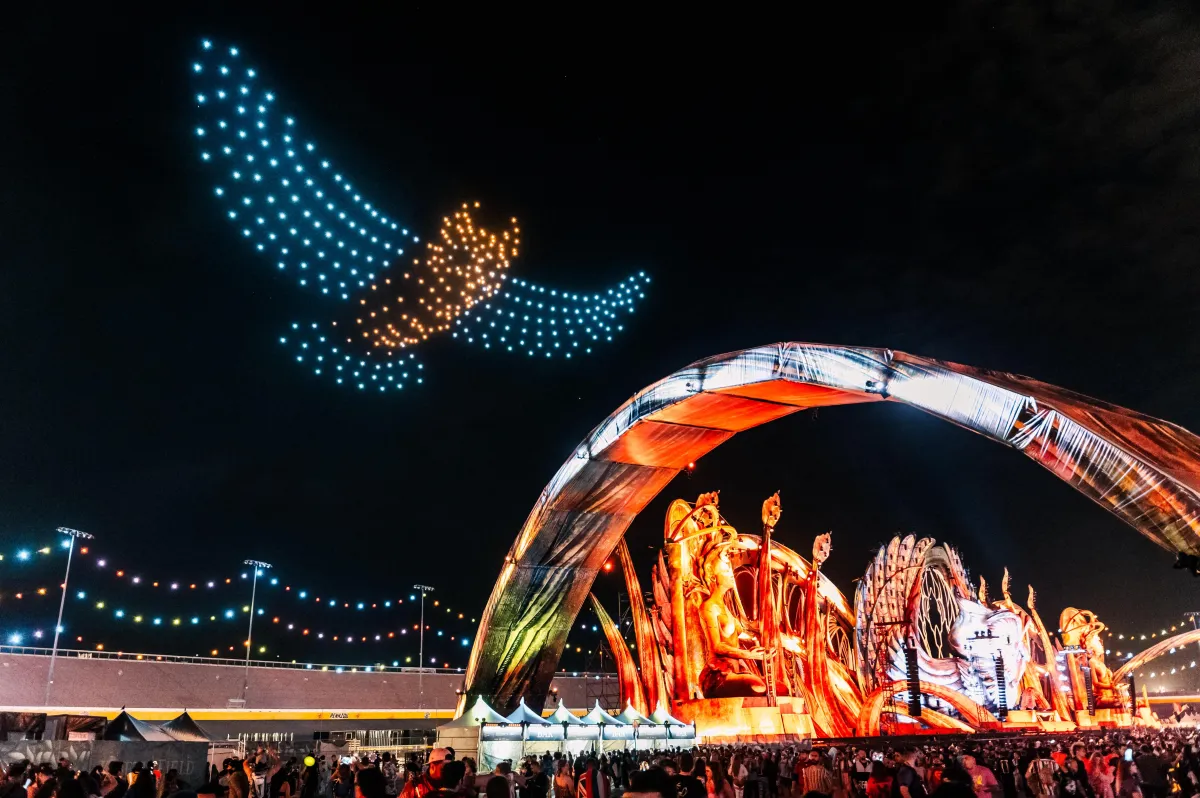
How Drone Shows Work: Unveiling the Sky's Symphony
Ever gazed in awe as a swarm of drones lit up the night sky, creating mesmerizing patterns and designs? These aerial spectacles aren't just random flights of fancy; they're the culmination of cutting-edge technology, meticulous planning, and artistic vision. Curious about how drone shows work?
Introduction to How Drone Shows Work
The spectacle of drones weaving intricate patterns against the backdrop of the night sky has captured the imagination of audiences worldwide. These shows represent the perfect marriage of technology and artistry, offering a fresh perspective on visual entertainment.
The Magic Behind the Skies
Imagine hundreds of drones, each a tiny speck in the vast expanse of the sky. Now, picture them moving in perfect harmony, creating shapes, letters, and even intricate animations. The magic lies in the choreography, a symphony of precise movements orchestrated by advanced software.
How Drone Shows Work
While the end result is a visual feast, the mechanics behind the breathtaking displays of synchronized lights and intricate patterns lie in a sophisticated system of technology, coordination, and innovation.
Flight Choreography
At the heart of every drone show is the choreography, the sequence of movements and formations that the drones follow. This choreography is meticulously planned using specialized software that allows designers to visualize the performance, program flight paths, and synchronize movements with lighting effects.
Each drone is assigned a specific role in the choreography, akin to a dancer in a ballet. They follow pre-defined flight paths, executing maneuvers with precision and grace. The software ensures that the drones maintain their formations, adjust their speed, and synchronize their movements in real-time, creating a seamless and harmonious performance.
Communication and Synchronization
Communication is key to the success of a drone show. Drones communicate with each other and the ground control station using wireless protocols. This communication allows them to receive instructions, exchange data, and adjust their positions in real-time.
Synchronization is crucial to ensure that all drones move in perfect harmony. Specialized algorithms coordinate the drones' actions, adjusting for variables such as wind speed, battery life, and GPS accuracy. This ensures that the drones maintain their formations and execute maneuvers with precision, creating a cohesive and visually stunning performance.
LED Lighting and Effects
The visual spectacle of a drone show is amplified by the use of LED lights. Drones are equipped with high-intensity LED lights that can produce a range of colors and patterns. These lights are programmable, allowing designers to create dynamic effects such as color transitions, flashing patterns, and pulsating rhythms.
The LED lights are synchronized with the drones' movements, creating a symbiotic relationship between light and motion. This integration of lighting effects adds depth, dimension, and drama to the performance, enhancing the overall visual impact and creating a mesmerizing spectacle that captivates audiences.
Safety Protocols
Safety is paramount in drone shows. Advanced software calculates the safe distance between each drone and its flight paths to prevent mid-air collisions and adjust their trajectories to avoid potential hazards. Geo-fencing is used to protect bystanders by creating a virtual boundary or perimeter around a specific geographic area.
Aside from the safety features integrated into the drones, a specialized ground crew actively monitors the performance in real-time from the ground station. They oversee the drones' movements, monitor battery levels, and intervene if necessary to ensure a safe and successful show. This multi-layered approach to safety ensures that the audience can enjoy the spectacle without compromising on security or well-being.
How Many Drones Are Needed for the Drone Show?
The number of drones needed for a drone show can vary significantly based on several factors, including the complexity of the performance, desired visual effects, budget constraints, and logistical considerations. Smaller events might use around 50 drones for a focused display, while larger ones can employ over 1,000 drones for a grand spectacle.
Impressively, the Guinness World Record for the largest aerial Nutcracker display used 1,499 drones in Texas, USA. Meanwhile, Guangdong, China, holds the record for the most UAVs airborne simultaneously with a staggering 3,051 drones. These records underscore the immense potential and scale of drone shows in creating captivating and record-breaking aerial displays.
Will Drones Replace Fireworks?
Fireworks have a long-standing tradition, cultural significance, and emotional appeal in celebrations and festivities. Yet, their use has been banned in numerous countries due to significant environmental and safety concerns.
Fireworks release pollutants, including heavy metals and particulate matter, into the atmosphere and surrounding environment, posing risks to ecosystems, wildlife, and public health.
Fireworks contribute to air pollution through the emission of toxic substances and generate high levels of noise that can disturb wildlife, pets, and individuals with sensitivities or anxiety related to loud noises.
Fireworks are inherently hazardous and can cause accidents, injuries, and property damage due to mishandling, or improper use, posing risks to spectators and surrounding areas during displays.
Fireworks pose fire hazards due to the ignition of flammable materials, hot debris, and sparks generated during use, increasing the risks of fires in communities, wildlife habitats, and natural landscapes.
On the other hand, drone shows introduce an inventive alternative, bringing a new class of entertainment that plays on numerous benefits. These include heightened safety measures, minimized environmental impact, creative versatility, and the ability to craft captivating aerial narratives. This sets the stage for a void-filling, groundbreaking era in aerial entertainment.
Benefits of Drone Shows
Beyond their visual appeal, drone shows offer several advantages over traditional entertainment options.
Eco-friendly and Efficient
In an era where sustainability is paramount, drone shows stand out as a greener alternative. They produce zero emissions and offer the flexibility to be reused for multiple performances, making them a sustainable choice for environmentally conscious events.
Dynamic Performances
Unlike static displays, drone shows offer dynamic performances with fluid movements and transitions, creating a visually stunning spectacle that evolves in real-time, engaging viewers and enhancing immersion.
Versatility in Design
From corporate logos to intricate animations, the design possibilities with drone shows are virtually limitless. With the right technology and creativity, drones can bring any vision to life, offering a bespoke entertainment experience tailored to the audience.
Adaptability
Whether hosting a small-scale event or a large-scale extravaganza, drone shows can be scaled to accommodate various venues, audiences, and logistical considerations, offering flexibility and adaptability for diverse entertainment needs.
Potential Risks of Drone Shows
While drone light shows undeniably offer numerous benefits and have rapidly gained popularity for their innovative and mesmerizing displays, they also introduce a set of challenges and considerations that cannot be overlooked.
Weather Concerns
Unpredictable weather conditions, such as strong winds, rain, or extreme temperatures, can significantly impact the performance and safety of drone displays. Adverse weather not only affects the drones' flight capabilities but also poses risks to the audience and surrounding infrastructure. Common weather-related challenges, such as reduced visibility, turbulent wind patterns, or precipitation, can compromise the drones' navigation, stability, and overall performance, necessitating stringent weather monitoring, contingency planning, and readiness to adapt or reschedule the show as needed.
Common Challenges
Drone shows can encounter common challenges, such as technical malfunctions, communication disruptions, and weather-related issues, that require swift and effective resolution to maintain the integrity and success of the performance. The ground crew must be ready to address these challenges proactively to deliver a seamless and memorable experience to audiences. Crucially, having contingency plans, including rescheduling or relocating the event, is vital for navigating unforeseen circumstances and prioritizing audience safety while preserving the show's excellence.
Audience and Public Safety
Ensuring audience and public safety during drone light shows is paramount, necessitating stringent safety measures, vigilant monitoring, and proactive risk mitigation strategies. Strict safety protocols, such as clear no-fly zones and comprehensive risk assessments, minimize hazards and create a secure operational environment.
Regulatory Compliance
Navigating the strict regulatory landscape is crucial when hosting a drone show. Each region may have its own set of rules and permits governing drone operations. Recognizing the value of compliance is paramount; it not only mitigates legal risks but also ensures the safety and success of the event.
Conclusion about How Drone Shows Work
Drone shows are a captivating blend of technology and art, offering a fresh and innovative way to dazzle audiences. Whether you're attending a show or planning one, understanding the intricacies behind these aerial spectacles adds another layer of appreciation. So, the next time you witness a swarm of drones painting the night sky, remember the dedication, creativity, and passion that went into making that magic happen.
FAQs
Are drone shows safe?
Yes, when conducted with proper planning and precautions. Drones are equipped with safety features to prevent mid-air collisions, and ground crews monitor the performance to ensure smooth execution.
How long can a drone show last?
The duration varies based on factors such as battery life, choreography complexity, and audience engagement. Shows can range from 5 to 20 minutes, offering flexibility in design and execution.
Can I host a drone show in my backyard?
Hosting a drone show in a backyard setting requires careful planning, adherence to local regulations, and consideration of space constraints. Consulting with professionals and obtaining necessary permits is essential to ensure a safe and successful event.
What happens if it rains during a drone show?
Rain can disrupt a drone show, affecting drone performance and potentially posing safety risks. It's essential to monitor weather conditions and have contingency plans, such as rescheduling or relocating the event, to ensure audience safety and maintain the show's integrity.
Are drone shows more environmentally friendly than fireworks?
Yes, drone shows offer a more sustainable entertainment option compared to traditional fireworks. They produce zero emissions, reduce environmental impact, and can be reused for multiple performances, aligning with global efforts towards sustainability and eco-conscious entertainment.

Copyright © Drone Guide Central - All Rights Reserved 2024

